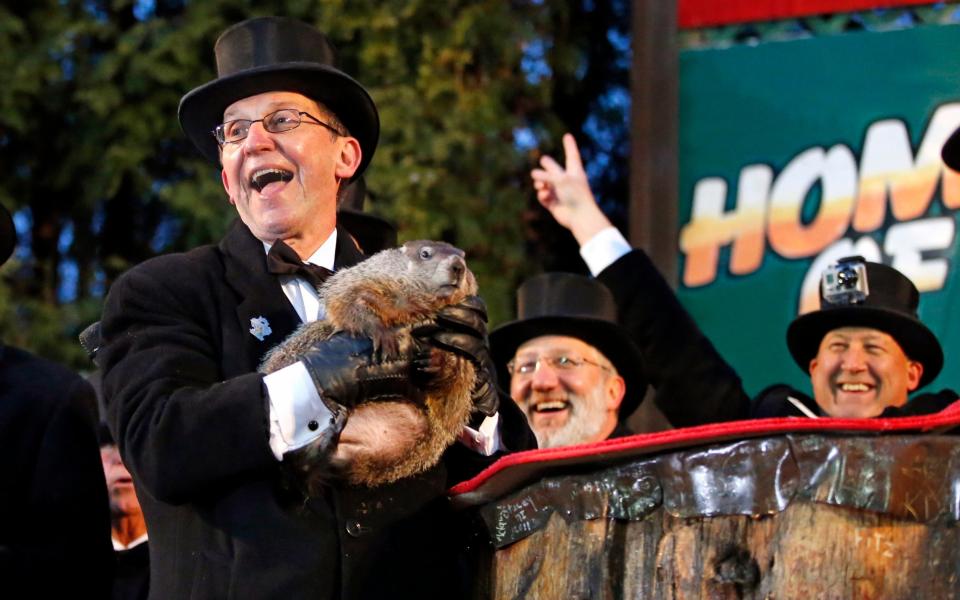Groundhog Day: how the Punxsutawney Phil prediction at Gobbler's Knob forecasts the weather

Every year a small community in the US gathers to watch a small animal emerge from its home, an act made famous by the 1993 film Groundhog Day starring Bill Murray. But how did this curious event come about?
Its centuries-old history draws on Christmas traditions, a North American marmot, and the mysterious-sounding 'Inner Circle'. Here is everything you need to know about the day - and about its star, Punxsutawney Phil.
What is Groundhog Day?
It is a traditional holiday celebrated in the US and Canada. According to folklore, if the weather is cloudy when a groundhog emerges from its burrow on February 2 – Candlemas – then spring will come early.
If it is sunny, the groundhog (a North American marmot with a greyish brown coat, weighing up to 9lb – in case you weren't sure) will see its shadow and retreat back inside, and winter will continue for another six weeks. Last year, Phil the groundhog didn't see its shadow and predicted an early spring to a crowd of on-lookers.
Based on the German lore that badgers are a forecasting animal, the tradition began as a custom among the German community in the US state of Pennsylvania in 1887.
The German lore apparently dictacted 'Sonnt sich der Dachs in der Lichtmeßwoche, so geht er auf vier Wochen wieder zu Loche', ('If the badger sunbathes during Candlemas-week, for four more weeks he will be back in his hole').
February 2 was traditionally marked by Germans as Candlemas, a Christian holy day which falls 40 days after Christmas Day. While for some Christians it was customary to take down Christmas decorations on January 6, for others it was normal to remove them on Candlemas.
A group of townspeople made a trip to Gobbler's Knob, a clearing a couple of miles away from Punxsutawney. There, they apparently consulted the groundhog on the coming weather – and people have gathered there to do the same every year since.

However the event was mentioned in the local newspaper, the Punxsutawney Spirit, the year before: "Up to the time of going to press, the beast has not seen its shadow". Because of this, many credit the publication's editor at the time, Clymer Freas, with the day's conception.
In Pennsylvania German, the day is called Grund'sau dåk, Grundsaudaag, Grundsow Dawg and Murmeltierta.
It is still celebrated today with many towns in the US and Canada kicking off festivities well before the winter sunrise, in time to watch a groundhog stepping out of a temporary burrow.
The world famous groundhog Phil is the chosen representative of the town of Punxsutawney where the largest celebration is held. Up to 40,000 people gather in Punxsutawney every year, which is almost eight-times the population of the town.
Punxsutawney Phil, the weather prognosticating groundhog
The state's hairiest meteorologist always gives his annual "forecast" on the top of the town's Gobbler's Knob, a tiny hill near the town which is about 104km northeast of Pittsburgh.
Those who hold the event pretend that the same groundhog makes the prediction every year, making Phil at least a supposed 133 years old this year.
Phil is cared for year-round by a tuxedo-wearing group called the Inner Circle. The group of local dignitaries, who are also responsible for planning the Groundhog Day prediction event, feed and take care of Phil.
How accurate is Phil?
Alas, according to Stormfax Almanac's data, Phil is only accurate 39 per cent of the time. The numbers do vary: in 2001 the Farmer's Almanac reported Phil has 50 per cent accuracy, while the 2001 journal Punxsutawney's Phenomenal Phorecaster claimed the predictions were 70 per cent accurate.
Records going back to 1887 show Phil has now predicted winter 104 times while forecasting an early spring just 19 times. In 2019, Phil predicted that the town would see an early spring.
Unfortunately for Phil, Tim Roche, a meteorologist at Weather Underground told Live Science that "you'll be better off flipping a coin than going by the groundhog's predictions".
So it's not a day celebrating repetition or déjà vu?
Ah, you are thinking of Groundhog Day, the 1993 film starring Bill Murray and Andie MacDowell. No.
The story follows Phil O’Connor (played by Bill Murray), an arrogant TV weatherman who finds himself caught in an endlessly repeating day while covering the Groundhog Day celebrations in Punxsutawney, Pennsylvania.
Whatever Phil does – be it a hedonistic one-night stand or throwing himself off a building – he wakes up in his hotel room at six o’clock on morning of 2 February with “I Got You Babe” by Sonny & Cher playing on the radio.
As he accepts his predicament, he focuses on improving his life and priorities, using his experiences to save lives and learn new skills, and eventually... let’s not spoil it in case there are still people out there yet to experience its unique and repetitive charms.
"Groundhog Day" has now become a reference to an unpleasant situation that seems to continually repeats itself.
The film has also consistently been voted among the top spiritual – and best Buddhist – films of all time.
Screenwriter Danny Rubin denies any spiritual intention, insisting he wrote the film simply to tell Phil’s story, but from the start fans have celebrated its deeper message.
In 2006 the film was granted cult classic status by being added to the United States National Film Registry as being “culturally, historically, or aesthetically significant”.

 Yahoo News
Yahoo News 